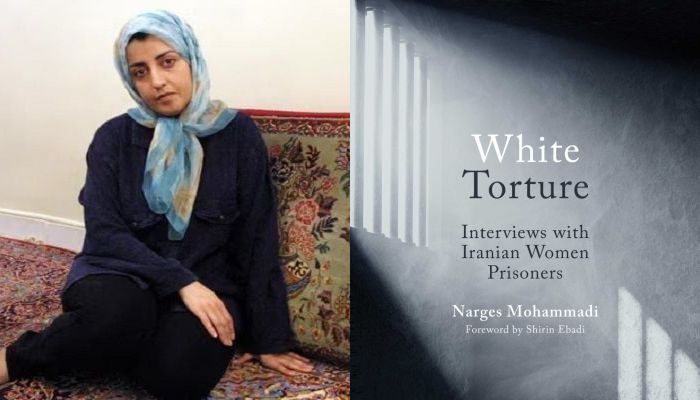
John Simpson
Publish: 06 Oct 2023, 07:43 pm

'White Torture' is a book written by Narges Mohammadi|| Photo: Collected
I can’t think when I last came across a book that opened
with such disturbing words: “I am writing this preface in the final hours of my
home leave. Very soon I will be forced to return to my prison … This time I was
found guilty because of the book you are holding in your hands – White
Torture.” That was last March. Narges Mohammadi, a leading Iranian political
dissident, had been briefly released from jail because she had had a heart
attack, followed by cardiac surgery. Now she is a prisoner again, facing 80
lashes and a total of more than 30 years behind bars. Part of her sentence will
be spent in solitary confinement. “I declare once more that this is a cruel and
inhumane punishment,” she writes. “I will not rest until it is abolished.”
Mohammadi builds up her campaign against solitary
confinement partly with her own story, but mostly through interviews with 12
other Iranian women who have also experienced it. They come from different
backgrounds and were jailed for a variety of things the Islamic republic
regards as crimes: being a member of the Bahá’i religious minority, or a Sufi,
converting to Christianity, supporting the People’s Mujahedin, or simply
getting involved in protest movements.
One, Hengameh Shahidi, was given almost 13 years for
complaining publicly about judicial corruption. After being released last year,
she is still under medical treatment as a result of being in solitary
confinement, and she has never been able to resume her normal life. “Solitary
confinement can amount to torture,” a UN special rapporteur told the United
Nations some years ago. White Torture demonstrates clearly how true that is.
Another of Mohammadi’s interviewees, Marzieh Amiri, is an
Iranian journalist, imprisoned for trying to find out what had happened to a
group of protesters. “I was returned to solitary confinement … At that moment I
saw myself as mad, and I experienced a fear that was not the fear of the
interrogator and the prison – I feared myself …. Your bedrock is the principle
of social life, and the solitary cell takes it all away from you.”
Prisoners, especially women, are being treated with
particular savagery in Iran at the moment. The regime has its back against the
wall, as the country experiences yet another phase of sub-revolutionary
upheaval. Past triggers were a blatantly stolen election (2009) and an
unacceptable rise in the price of fuel (2019).
This time, the protests go to the very heart of the way
people are obliged to live their lives under the Islamic republic. After the
death of 22-year-old Mahsa Amini in police custody for not wearing proper
hijab, the demonstrations have not been about the government’s crookedness or
economic inadequacy; they have been about the way it tries to control people’s
behaviour.
Almost every day, crowds come out on the streets to protest.
Sometimes they attack public buildings. Sometimes they set fire to police cars.
Mostly, though, they dance and sing and chant, and the women among them pull
off their headscarves and shake their hair free as a sign that they are no
longer bound by the state’s rules. But there is a heavy price to be paid for
this taste of freedom. The Oslo-based group Iran Human Rights says that as of
12 November, the police, army, and basij militia have killed at least 326
people, including 25 women and 43 children. The Islamic republic declares war
on those who challenge it.
Will the demonstrators win? I think they must, at some
stage, but not immediately. There is no discernible leadership to the protests,
and if the supreme leader, Ayatollah Khamenei, President Raisi and the rest of
their increasingly incompetent regime were sent packing, Iran would be thrown
into utter chaos: worse, maybe, than the terrible period after the Shah was
overthrown and there was near civil war between the new state and its extreme
opponents.
What the present demonstrations show is the degree to which
an elderly, ultra-rigid politico-religious system has long passed its sell-by
date. Iran has a population of 85 million, half of them educated and
outward-looking, and thoroughly aware how weird and antiquated their government
is. The demonstrations are their response.
In Tehran in November 1978, with a million people in the
streets chanting “Marg bar Shah!” and “Javid Khomeini!” (death to the Shah,
long live Khomeini), I took refuge from the teargas and bullets in a shopping
arcade, with an Iranian university professor. He tried to persuade me that even
though the leader of the revolution was an exiled septuagenarian cleric, the
new Iran would be advanced and decent and respected in the world.
“No more torture?” I asked. “Of course not.” Mohammed doesn’t write to me nowadays because he’s scared the authorities will read his emails; but he long ago confessed he had been grossly, almost childishly overoptimistic about the way the Islamic Revolution would turn out. The people in the streets today show something of the same innocence. When the rule of the ayatollahs comes to an end, will “white torture”, plus every other type of torture, vanish from Iran with them? I wish I thought it would._The Guardian
(John Simpson is the BBC’s world affairs editor. His
weekly programme, Unspun World, is on BBC Two, BBC World, BBC World Service and
iPlayer. White Torture: Interviews with Iranian Women Prisoners is published by
Oneworld (£20).)
Subscribe Shampratik Deshkal Youtube Channel
Topic : White Torture Narges Mohammadi book review Iran
© 2024 Shampratik Deshkal All Rights Reserved. Design & Developed By Root Soft Bangladesh